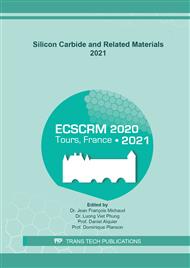p.613
p.619
p.627
p.632
p.637
p.642
p.647
p.653
p.658
Design of an Integrated Power Module for Silicon Carbide MOSFET with Self-Compensation of the Magnetic Field
Abstract:
Compactness, efficiency, and light weight are the key topics in the design of power conversion systems for transportation applications. This demand is achievable by using wide band gap devices such as SiC devices, characterized by the high switching speed and low on-resistance. However, this trend imposes new challenges and the effect of parasitic elements of power package during switching transient becomes significant. Hence, new packaging solutions should be investigated for addressing this concern. This paper presents a new multichip power module architecture, where its design considering capacitive and inductive stray elements is carried out. Using Ansys Q3D Extractor, electromagnetic simulations are achieved to extract the inductive and capacitive parasitic element of one leg of a three-phase inverter.
Info:
Periodical:
Pages:
637-641
Citation:
Online since:
May 2022
Permissions:
Share:
Citation:


